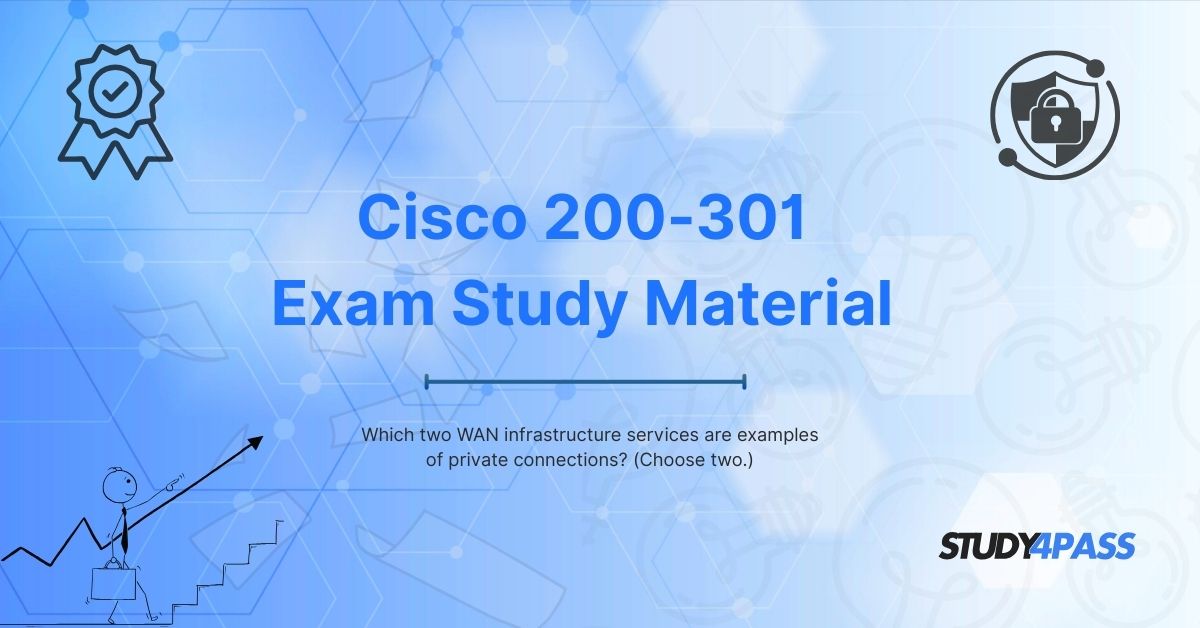Introduction
In the world of networking, Wide Area Network (WAN) infrastructure services play a crucial role in connecting geographically dispersed locations. Among these services, some are designed to provide private, secure, and dedicated connections, ensuring reliable data transmission between sites.
For those preparing for the Cisco Certified Network Associate (CCNA) 200-301 exam, understanding WAN technologies is essential. This article explores two key WAN infrastructure services that serve as examples of private connections: MPLS (Multiprotocol Label Switching) and leased lines.
Additionally, if you're looking for high-quality study materials for CCNA, CCDA, CCENT, CCNA Security, and CCNA Wireless, Study4Pass is an excellent resource. Their structured courses, practice exams, and expert guidance can help you achieve certification success.
Understanding WAN Infrastructure Services
A Wide Area Network (WAN) connects multiple Local Area Networks (LANs) across large distances. Businesses use WAN services to ensure seamless communication between branches, data centers, and cloud services.
WAN connections can be categorized into:
- Public connections (e.g., the Internet)
- Private connections (dedicated, secure links)
Private WAN connections offer better security, reliability, and performance compared to public networks.
Two Examples of Private WAN Connections
A. MPLS (Multiprotocol Label Switching)
MPLS is a high-performance WAN service that uses labels to route data efficiently. Unlike traditional IP routing, MPLS forwards packets based on predefined labels, reducing latency and improving traffic management.
Key Features of MPLS:
- Private and Secure: MPLS provides a dedicated path between sites, minimizing exposure to public networks.
- Quality of Service (QoS): Supports prioritization of critical traffic (e.g., VoIP, video conferencing).
- Scalability: Easily accommodates growing network demands.
- Reliability: Offers low packet loss and consistent performance.
Use Cases:
- Enterprise networks with multiple branches
- Cloud connectivity
- VoIP and unified communications
MPLS is widely adopted by businesses that require secure and predictable WAN performance.
B. Leased Lines (T1/E1, T3/E3, Optical Carrier Lines)
A leased line is a dedicated point-to-point connection between two locations. Unlike shared connections, leased lines provide exclusive bandwidth, ensuring consistent speeds and uptime.
Key Features of Leased Lines:
- Dedicated Bandwidth: Guaranteed speeds without contention from other users.
- High Availability: Service Level Agreements (SLAs) ensure uptime and reliability.
- Low Latency: Ideal for real-time applications like video calls and financial transactions.
- Security: Data travels through a private circuit, reducing exposure to cyber threats.
Common Types of Leased Lines:
- T1 (1.544 Mbps) / E1 (2.048 Mbps) – Traditional leased lines for small businesses.
- T3 (45 Mbps) / E3 (34 Mbps) – Used by medium to large enterprises.
- Optical Carrier (OC-3, OC-12, OC-48) – Fiber-based high-speed connections.
Use Cases:
- Connecting corporate offices
- Data center interconnections
- Financial institutions requiring secure transactions
Leased lines remain a preferred choice for organizations needing guaranteed performance.
Comparison of MPLS vs. Leased Lines
|
Feature |
MPLS |
Leased Line |
|
Connection Type |
Shared infrastructure (logically private) |
Dedicated physical line |
|
Scalability |
Highly scalable |
Limited by physical infrastructure |
|
Cost |
Moderate (shared backbone) |
Expensive (exclusive bandwidth) |
|
Performance |
QoS-enabled, reliable |
Guaranteed bandwidth, low latency |
|
Best For |
Enterprises with multiple sites |
Businesses needing fixed, high-speed links |
Both MPLS and leased lines provide private connectivity, but the choice depends on budget, scalability needs, and performance requirements.
Why Choose Private WAN Connections?
Advantages Over Public Networks (Internet-Based VPNs)
- Enhanced Security: Reduced risk of cyberattacks compared to public internet.
- Predictable Performance: No bandwidth fluctuations due to shared usage.
- Better SLAs: Guaranteed uptime and support from service providers.
- Ideal for Critical Applications: Supports VoIP, ERP systems, and cloud services without interruptions.
For businesses handling sensitive data, private WAN connections are indispensable.
Study4Pass – Your Ultimate CCNA Certification Resource
Preparing for Cisco Certifications (CCNA, CCDA, CCENT, CCNA Security, CCNA Wireless) requires reliable study materials and expert guidance. Study4Pass offers:
- Comprehensive CCNA 200-301 Study Guides – Covering all exam objectives.
- Practice Tests with Real Exam Scenarios – Boosting confidence before the actual test.
- Video Tutorials & Hands-On Labs – Reinforcing theoretical knowledge with practical skills.
- Expert Support – Access to networking professionals for doubt resolution.
- By choosing Study4Pass, you get a structured learning path that maximizes your chances of passing the CCNA exam on the first attempt.
Visit Study4Pass today and accelerate your networking career!
Conclusion
When selecting WAN infrastructure services for private connections, MPLS and leased lines are two of the most reliable options. MPLS offers flexibility and scalability, while leased lines provide dedicated bandwidth and high security.
For CCNA 200-301 aspirants, mastering WAN technologies is crucial. Leveraging resources like Study4Pass can streamline your preparation, ensuring you gain the expertise needed to excel in Cisco certifications.
Whether you're aiming for CCNA, CCNA Security, or CCNA Wireless, investing in the right study materials will set you on the path to success.
Special Discount: Offer Valid For Limited Time “200-301 Exam Material”
Actual Exam Questions For Cisco's 200-301 Certification
Sample Questions For Cisco 200-301 Exam
1. Which of the following are examples of private WAN connections? (Choose two.)
a) MPLS
b) Public Internet
c) Leased Line
d) DSL
2. Which two WAN services provide dedicated private connectivity? (Choose two.)
a) Cable Internet
b) Frame Relay
c) 4G LTE
d) Metro Ethernet
3. Identify two private WAN infrastructure services from the options below. (Choose two.)
a) Satellite Internet
b) VPN over Internet
c) T1/E1 Line
d) ATM
4. Which of these are considered private WAN connections? (Choose two.)
a) Dial-up
b) Ethernet WAN
c) ISDN
d) Dark Fiber
5. Select two private WAN services from the following. (Choose two.)
a) Broadband
b) MPLS VPN
c) Wireless WAN
d) Point-to-Point (P2P)


